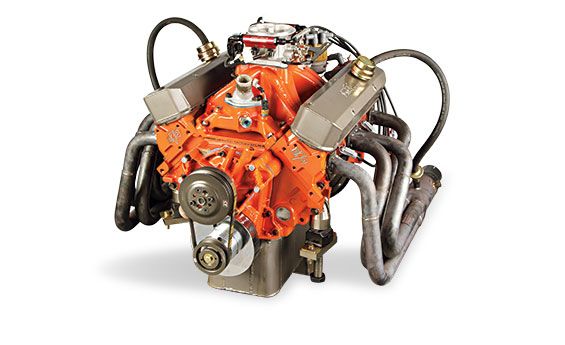
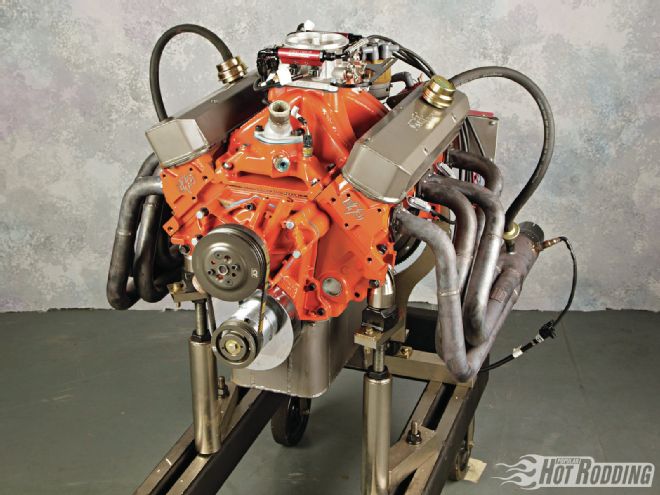
What defines a good engine build? For some, nothing matters but the big number on the dyno chart, but just as relevant to us is how you get there. The 417-cube Mopar small-block featured here from Jesse Robinson and the crew at SKMFX Engines in Summerstown, Ontario, Canada, provides a perfect illustration. Built with sights set on competing in the 2012 AMSOIL Engine Masters Challenge, a quick scan of the parts list would have pointed to a mild-mannered street build. The surprise comes when the parts list is put up against the actual power. With 580 hp and 552 lb-ft of torque on hand, the power curve would suggest there has to be something more at play. Frankly, there is, and that intangible element is outstanding execution to get the most out of the parts that went into the mix. Robinson's goal in this build was to use everyday performance parts in a very common configuration, and then work to show the true potential on tap.
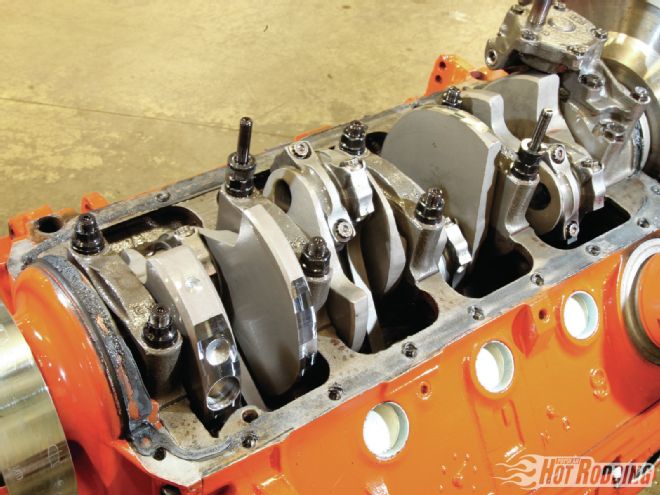 Jesse Robinson and the crew from SKMFX Engines set out to build extraordinary power from commonplace parts. Serving as the foundation for the build is nothing more exotic than a late ’70s Mopar 360 block with a partial fill, and retaining the OEM two-bolt main caps upgraded with ARP fasteners. With a tall 9.6-inch factory deck, there’s easy clearance for a 4.00-inch stroke crank.
Jesse Robinson and the crew from SKMFX Engines set out to build extraordinary power from commonplace parts. Serving as the foundation for the build is nothing more exotic than a late ’70s Mopar 360 block with a partial fill, and retaining the OEM two-bolt main caps upgraded with ARP fasteners. With a tall 9.6-inch factory deck, there’s easy clearance for a 4.00-inch stroke crank.
Simple Stroker
In the Mopar world, stuffing a 4.00-inch stroke crank in a factory small-block is one of the most common and popular engine combinations. With the block's tall 9.6-inch deck height, ample crankcase and camshaft clearance, and OEM-length 6.123-inch connecting rods, this is an engine block begging for a longer crank, and it all readily fits in the available space with minimal grinding, reworking, or unexpected hassles. There's no need for a special reduced cam base circle, custom-length rods, or undersized compression height on the pistons. It's simple and straightforward, and that's one of the reasons Robinson elected to go this route. "The general idea was to do a budget-minded build aimed at the average street guy who walks in my door. They never want a stock-stroke build, they always want a 4-inch stroke in a small-block Mopar. The issue is often the project budget and how much cylinder head they are willing to use. I wanted to see how much we could get out of the EngineQuest cylinder head."
Adding cubes to the Mopar small-block is a practical approach, given the factory options. The largest Chrysler OEM small-block displacement was 360 ci, leaving big-block swaps as the old solution for stepping up the volume. As Robinson relates, the stroker is a much more practical and cost-effective solution: "The stroker combination opens the door for big cubic inches in a small-block platform. This is a big advantage, providing a bolt-in solution rather than a much more complicated big-block swap." Although these stroker combinations are readily applicable to the small-journal 318 and 340 engine blocks, Robinson prefers the common 360 block as the basis of a typical street build: "I like the larger mains of the 360 block for more journal overlap, which make the crank more ridged with the long stroke." The crank employed is a 4340 forged steel unit from Eagle.
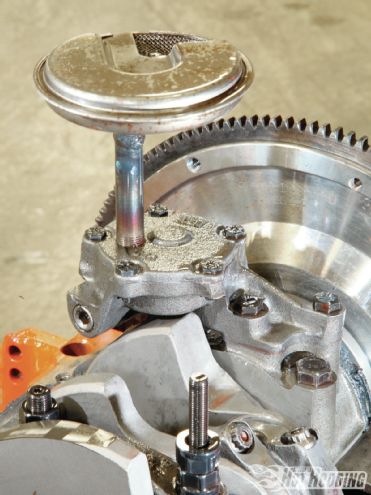 A replacement-style Melling oil pump circulates the lube, though it is modified with the pickup relocated to the pump cover. This eased the fabrication of the oil pickup in the custom pan, and actually improves oil delivery to the pump’s rotors.
A replacement-style Melling oil pump circulates the lube, though it is modified with the pickup relocated to the pump cover. This eased the fabrication of the oil pickup in the custom pan, and actually improves oil delivery to the pump’s rotors.
Prepping the production-based block itself was an exercise in simplicity, with a definite lack of trick-of-the-week parts. You'll find the block was given quality machining in the form of basic block prep operations, with attention to detail such as an expert final bore finish performed by Joe Rutters. SKMFX retained the OEM main caps, though ARP studs were added to improve clamping. As Robinson tells us, "When dealing with these power levels, I find the factory two-bolt main arrangement more than adequate for longevity, provided you have good ARP studs and proper machining procedures in preparing the mains. We touched up the center three main feeds for the proper diameter and enlarged the pickup to the oil pump to a half inch."
The relatively large final bore oversize of .070 inch was actually a result of the bores already being sized at .060-inch over, rather than some quest for maximum cubic inches. To aid cylinder rigidity, the water jackets were partially filled. At .070 inch, the bore accepts shelf pistons for a .030-inch over, 4.00-inch stroke Mopar 340 block, which comes from the factory with a slightly larger bore than the 360. Robinson expands: "The .070-inch oversize is readily available; I chose KB's Icon forged pistons because they have the correct 20.5cc dish size to bring the compression ratio under 10.5:1 with the chamber size being used. I've had good experience with these pistons, and they are cheap and readily available."
The Icon pistons accept a common 1/16-, 1/16-, 3/16-inch ring package, accommodated by a set of Mahle Clevite rings. Robinson prefers a ring package with the Napier-faced second ring. "I put a Napier ring in the second groove; it's a combination that I have come to really like. If I'm tracking blow-by on the dyno or inspecting the exhaust ports or spark plugs, they are just always sealed up and dry. I think they pick up where the oil ring leaves off."
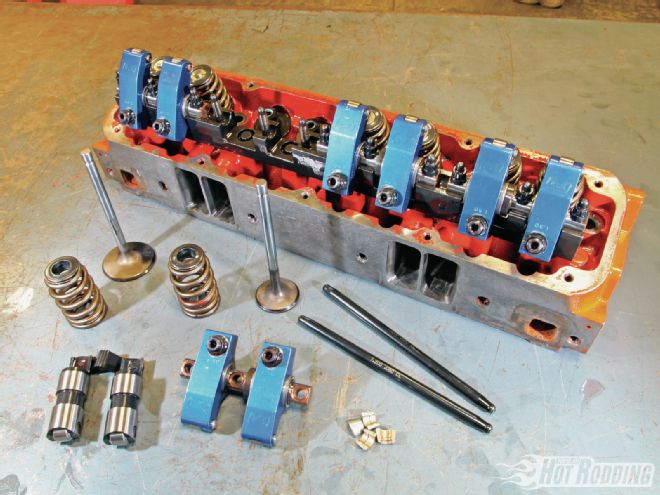 Getting the most from a hydraulic roller lifter arrangement with fast-acting lobes takes a valvetrain up to the task, with minimal deflection. The engine takes advantage of T&D 1.5:1 ratio shaft-mounted rockers, Trend ⅜-inch pushrods, and PAC beehive springs working a set of 2.08/1.60-inch Manley Severe Duty valves. All of this hardware is loaded into a set of EngineQuest 318B iron heads.
Getting the most from a hydraulic roller lifter arrangement with fast-acting lobes takes a valvetrain up to the task, with minimal deflection. The engine takes advantage of T&D 1.5:1 ratio shaft-mounted rockers, Trend ⅜-inch pushrods, and PAC beehive springs working a set of 2.08/1.60-inch Manley Severe Duty valves. All of this hardware is loaded into a set of EngineQuest 318B iron heads.
Connecting the pistons to the crank is an affordable set of Scat I-beam rods. These lightweight forgings are compact at the big end, helping with stroker clearance, and have proven quite capable at the power level considered here. The overall bottom end configuration yields a displacement of 417 ci from the factory 360 block, and is both easy to assemble and affordable. Robinson relates: "The small Mopar is so nice because I only needed to grind very small notches at the bottoms of the cylinders; the Scat I-beam rods with the cap screws aid the clearance. By using readily available parts in a conventional stroker combination, the package offers great value. For just the short-block with machining included without a core charge, I think you can get something like this put together for between $2,400 and $2,800 out the door, which I consider very reasonable for this many cubic inches."
Power Parts
To make them work to their potential, the added cubic inches of the stroker short-block rely on the correct team of complementary parts. Robinson tells us, "The cylinder heads have the most important effect on the overall build. I have put these kinds of stroker engines together with stock Mopar J-heads, and you'll only see 460 hp and they will be all done at 5,300 rpm. This might be appropriate for a pickup truck or a large Mopar C-Body, but it isn't going to make it as a performance engine in a lightweight A-body." As cylinder heads also play a major role in the overall cost of the engine project, Robinson sought to explore the potential of EngineQuest's budget-oriented iron heads. Robinson continues, "The basic cost of the EQ heads is a real bargain, and then there are the related cost savings in the headers, intake, and valvetrain with the OEM layout."
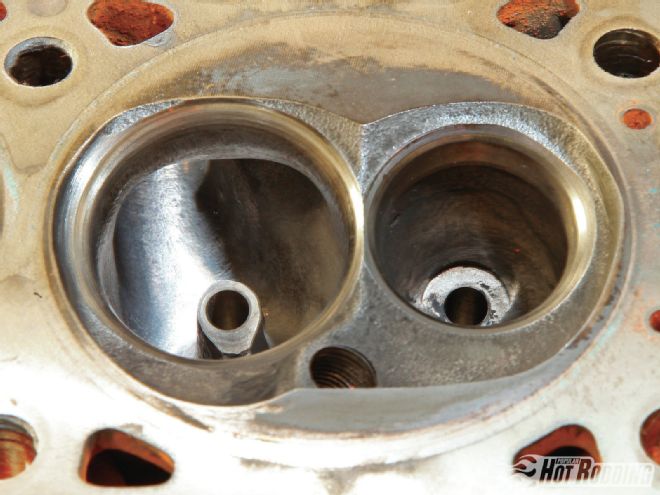 The iron EQ cylinder heads are much improved over a factory Mopar Magnum head right out of the box. To really show the potential of these castings, porting work at SKMFX focused primarily on the intake port, achieving a remarkable flow level of over 300 cfm. The exhaust ports also received a mild rework, as did the chamber and valve seats.
The iron EQ cylinder heads are much improved over a factory Mopar Magnum head right out of the box. To really show the potential of these castings, porting work at SKMFX focused primarily on the intake port, achieving a remarkable flow level of over 300 cfm. The exhaust ports also received a mild rework, as did the chamber and valve seats.
While the heads offer excellent performance in their stock configuration, especially at stock displacement, the heads become more critical on larger stroker engines. To really dig into the potential of these castings, Robinson embarked on a development and modification program. "I was shooting for overall port volume and cross-section, knowing that with 417 ci I was going to need every bit of real estate I could get. The main focus was on the intake port; I ended up lowering the floor substantially, and managed to open up the runner in the pushrod area to 2.350 square inches. This could be expanded upon by sleeving the pushrod holes, but this would be getting away from the overall theme of the modifications." The effort resulted in intake flow topping the 300-cfm mark.
Even the best cylinder heads will perform far under their potential if the induction system puts a cork in the flow stream. Here Robinson went to work on Edelbrock's new Super Victor intake for the Mopar small-block. As Robinson explains, "I was pretty excited to use the Super Victor intake. I worked the plenum pretty extensively, again with an eye toward overall cross-section based upon the cubic-inch and rpm range of the engine. I was looking for a happy medium between cross-section and runner length. I feel there is room for improvement there still."
Bolted to the big Edelbrock single-plane intake manifold is a 1,000-cfm FAST EZ-EFI throttle-body injection system. Robinson had good things to say about this system, "The EZ did what it was supposed to do, as far as being a bolt-on carburetor replacement with basic tuning parameters. It did perform quite well, with very few issues. On initial fire up I used one of my go-to carburetors and saw almost 570 hp with the carb. I moved on from there thinking that if the EFI could match that or come close to that output I would be happy.
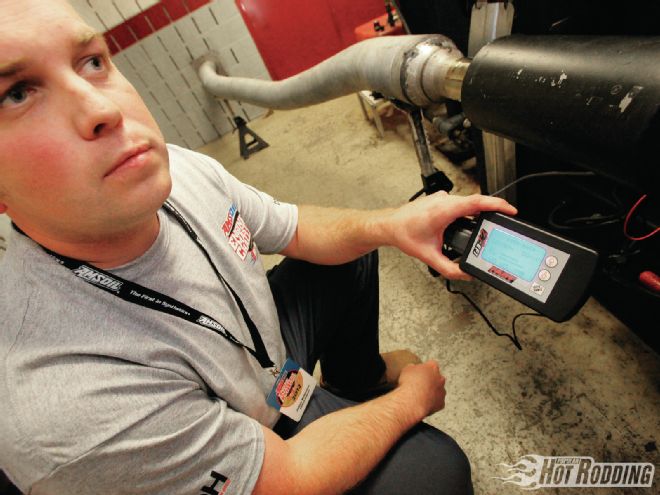 Tuning the FAST TBI is assisted through a handheld tuning module. The software is designed to be as user friendly as possible, making the EZ an ideal arrangement for those with limited experience with EFI systems and tuning.
Tuning the FAST TBI is assisted through a handheld tuning module. The software is designed to be as user friendly as possible, making the EZ an ideal arrangement for those with limited experience with EFI systems and tuning.
As it turned out the FAST EFI actually made more power at peak. From what I could determine the fuel distribution was very good. This whole engine package is aimed at the average guy who wants to put something relatively simple together without the complexity of a port injection system. The throttle-body injection from FAST fit this role perfectly."
Working in conjunction with the FAST fuel system is a programmable ignition system from MSD. With the advance requirements working electronically, there was no longer a need for a distributor with any type of advance provisions. Robinson went with a factory Chrysler distributor from their infamous "lean-burn" ignition system, which features the triggering function of the magnetic pickup only. This unusual arrangement functioned as though the components were designed to work together and performed without fail.
The final key ingredient to this power package was the cam and related valvetrain. Here Robinson opted for a hydraulic roller, using a custom cam from COMP. Robinson reveals, "The cost from COMP for a custom cam is comparable to a shelf cam, so a custom cam is definitely the way to go. You can also specify a cast core, so you remove the requirement for a bronze distributor drive, which is a benefit for the street. I don't like having a consumable part in an engine. A big plus with the hydraulic roller is not having to fear wiping out a flat-tappet lobe. I wouldn't use a hydraulic roller with an offset rocker head like a W2. I find they don't get along very well, and it is just not a good combination. They work very well, however, on a non-offset rocker head like these iron EngineQuests. I wanted .650-plus lift on the intake side and used COMP's HHR lobes, but used lobes that are much slower on the exhaust. With the cubic inches and cylinder head combination I thought the engine could benefit from a little wider lobe separation to broaden the power curve."
The supporting components in the valvetrain are no area to skimp if you're looking to make the most of a camshaft and have it endure over the long haul. Here the bulletproof T&D rockers certainly meet the quality requirement, though Robinson suggests that a conventional rocker arrangement can also provide outstanding results. Robinson stresses high strength and quality valvetrain parts: "I am in the camp that weight takes a back seat to stability and rigidity in the valvetrain. I really like these Scorpion lifters; they are just fantastic quality parts, made in the United States, for a very good price."
So, in summary this engine package represents the common man's Mopar stroker—a very ordinary 360 production block filled with regular street stroker internal parts. With the iron EQ Magnum-style heads, hydraulic roller cam, cast Edelbrock manifold, and street-style throttle-body injection, it might be your average mid 400hp street mill. The dyno chart, however, proves otherwise, with the curve peaking at the 6,000-rpm mark, producing stout output in the upper 500s. A key ingredient is the custom work to the heads and induction, helping move air through the big small-block. While these kinds of numbers might represent the upper realm of output possible from such a basic parts list, it also serves as a benchmark of what could be done when that basic parts list is fortified with sensible engine-building know-how and an extra helping of careful craftsmanship.
CFM of Airflow
EngineQuest 318B Cylinder Head
Lift (inches): Intake, stock* Intake, modified** Exhaust, stock* Exhaust, modified** .100 66.2 65.0 54.7 56.0 .200 121.4 132.0 101.0 110.0 .300 179.0 189.0 142.0 150.5 .400 214.5 240.0 168.0 168.0 .500 226.2 278.0 174.0 178.0 .600 235.5 300.0 175.0 184.0 .700 238.0 301.0 not recorded 185.0
*Stock with 1.92-/1.625-inch valves
**Modified with 2.08-/1.600-inch valves
On The Dyno
RPM: TQ: HP: 2,500 454 216 2,600 453 224 2,700 453 233 2,800 455 242 2,900 456 252 3,000 454 260 3,100 450 266 3,200 445 271 3,300 442 277 3,400 440 285 3,500 441 294 3,600 445 305 3,700 455 320 3,800 470 340 3,900 483 359 4,000 492 374 4,100 502 392 4,200 514 411 4,300 528 432 4,400 539 451 4,500 545 467 4,600 549 481 4,700 551 493 4,800 551 504 4,900 552 515 5,000 551 525 5,100 551 535 5,200 550 545 5,300 548 553 5,400 546 561 5,500 542 567 5,600 536 571 5,700 529 575 5,800 522 577 5,900 515 579 6,000 507 580 6,100 499 579 6,200 490 578 6,300 481 577 6,400 472 575 6,500 462 572
By The Numbers
417ci Mopar Small-Block
Block: OEM 360 Bore: 4.07 inches Stroke: 4.00 inches CID: 417 ci Compression ratio: 10.3:1 Crankshaft: Eagle 4340 Camshaft: COMP Cams hydraulic roller Timing chain: Rollmaster Red series Lifters: Scorpion hydraulic roller Pushrods: Trend ?-inch, 7.2-inch long with 210 tip Springs: PAC 1255 beehive Installed height: 1.9 inches Spring load, closed: 165 pounds at 1.900 inches Spring load, open: 425 pounds at 1.250 inches Retainer: PAC 10-degree, steel Valve locks: COMP 10-degree plus .050 inch Duration, intake: 250 degrees at .050 Intake lift: .663 inch Duration, exhaust: 252 degree at .050 Exhaust lift: .594 inch Rockers: T&D Rocker ratio: 1.5:1 Lobe separation: 108 degrees Installed centerline: 105.5 degrees Ring pack: Mahle Clevite 1/16-,1/16-, 3/16-inch Ring endgap: .018-inch top, .024-inch second Piston: Icon PN 745, dished Piston clearance: 0.0055 inch Main fasteners: ARP studs Rods: Scat 6.123-inch I-beam Main bearings: Clevite HG Rod bearings: Clevite HNK Main journal diameter: 2.810 inches Rod journal diameter: 2.125 inches Main clearance: .0025 inch Rod clearance: .0025 inch Cylinder heads: EngineQuest CH318B Chamber volume: 59 cc Head fasteners: Fel-Pro head bolts Intake manifold: Edelbrock SuperVictor Intake port flow: 303 cfm at .600 Exhaust port flow: 193 cfm at .600 Intake valve: Manley Severe Duty, 2.08 inches Exhaust valve: Manley Severe Duty, 1.60 inches Cylinder head gaskets: Fel-Pro 519SD (.044 inch) Piston/head clearance: .050 inch Engine gaskets: Fel-Pro Fuel delivery: COMP Cams EZ-EFI 1,000 cfm Carb spacer: none Header: Schoenfeld 1? to 1¾, stepped Coil: MSD Ignition: MSD 6AL-2 Spark plug wires: MSD Superconductor Damper: CAT Water pump: NAPA OEM Oil pan: SKMFX, custom aluminum oil pan Oil pump: Melling M72 Oil: AMSOIL 15w50 Fuel: unleaded, VP Racing Fuels VP100
On The Bench: EngineQuest Magnum Heads
EngineQuest's Magnum heads (PN 318B) and its LA-Series counterpart (the 318A) are iron replacement-style cylinder heads designed to bolt in place of tired or cracked originals. Fortunately, EngineQuest invested the effort to substantially improve on the factory design through a process of detail refinement rather than radical design changes. What results is a head that does double duty, serving as an economical replacement for OEM, while supporting the needs of a low-cost mild performance unit. The heads are cast in Australia, using a technique that produces an exceptionally smooth port surface for more flow and power, with 172cc intake runners and 62cc combustion chambers. In box-stock form, these heads offer superior quality at an affordable price with no additional machining, porting, or polishing required.
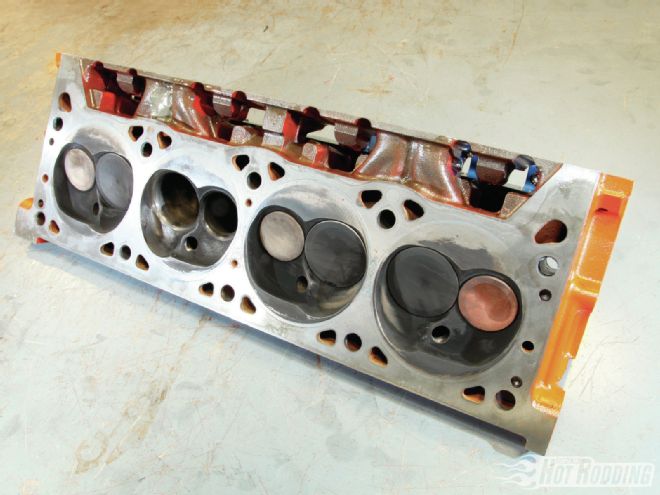
While the EngineQuest heads represent a bolt-on upgrade to a stock cylinder head, there is always room for improvement with custom porting work and modification. SKMFX explored the potential of these heads with a determined development effort to see how much airflow could be unlocked from these modest castings. The results were dramatic, as seen in the flow table below. While the modified flow numbers from SKMFX are among the best we have ever seen for a production-style head, the "as-cast" flow numbers are also very impressive. This range of flow numbers represent the potential on tap, depending upon the level of modification performed. For more information about EQ's Magnum Cylinder heads, call 800-426-8771 or log on to www.EngineQuest.com.